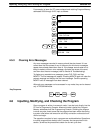
45
Except for the SHIFT key on the upper right, the gray keys are used to input
instructions and designate data area prefixes when inputting or changing a
program. The SHIFT key is similar to the shift key of a typewriter, and is used
to alter the function of the next key pressed. (It is not necessary to hold the
SHIFT key down; just press it once and then press the key to be used with
it.)
The gray keys other than the SHIFT key have either the mnemonic name of
the instruction or the abbreviation of the data area written on them. The func-
tions of these keys are described below.
Pressed before the function code when in-
putting an instruction via its function code.
Pressed to enter SFT (the Shift Register
instruction).
Input after a ladder instruction to designate
an normally closed condition.
Pressed to enter AND (the AND instruc-
tion) or used with NOT to enter AND NOT.
Pressed to enter OR (the OR instruction)
or used with NOT to enter OR NOT.
Pressed to enter CNT (the Counter instruc-
tion) or to designate a TC number that has
already been defined as a counter.
Pressed to enter LD (the Load instruction)
or used with NOT to enter LD NOT. Also
pressed to indicate an input bit.
Pressed to enter OUT (the Output instruc-
tion) or used with NOT to enter OUT NOT.
Also pressed to indicate an output bit.
Pressed to enter TIM (the Timer instruc-
tion) or to designate a TC number that has
already been defined as a timer.
Pressed before designating an address in
the TR area.
Pressed before designating an address in
the LR area. Cannot be used with the K-type
PCs.
Pressed before designating an address in
the HR area.
Pressed before designating an address in
the DM area.
Pressed before designating an indirect DM
address. Cannot be used with the K-type
PCs.
Pressed before designating a word address.
Pressed before designating an operand as a
constant.
Pressed before designating a bit address.
4-4-2 PC Modes
The Programming Console is equipped with a switch to control the PC mode.
To select one of three operating modes—RUN, MONITOR, or PROGRAM—
use the mode switch. The mode that you select will determine PC operation
as well as the procedures that are possible from the Programming Console.
RUN mode is the mode used for normal program execution. When the switch
is set to RUN and the START input on the CPU Power Supply Unit is ON, the
CPU will begin executing the program according to the program written in its
Program Memory. Although monitoring PC operation from the Programming
Console is possible in RUN mode, no data in any of the memory areas can
be input or changed.
MONITOR mode allows you to visually monitor in-progress program execu-
tion while controlling I/O status, changing PV (present values) or SV (set val-
ues), etc. In MONITOR mode, I/O processing is handled in the same way as
in RUN mode. MONITOR mode is generally used for trial system operation
and final program adjustments.
Gray Instruction and Data
Area Keys
The Programming Console Section 4-4


















